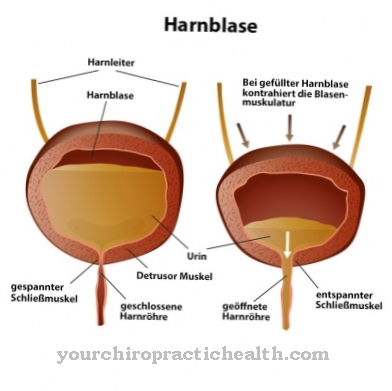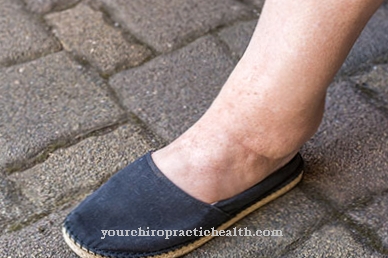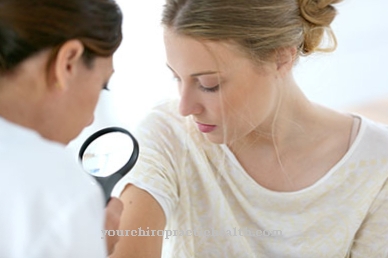At Lichen planus it is a skin disease, also commonly called Nodular lichen referred to as. The disease manifests itself through inflammation that causes changes in the skin and is accompanied by severe itching.
What is lichen planus?
.jpg)
© designua - stock.adobe.com
Owes its name Lichen planus the typical nodule formation on the skin. These nodules occur both sporadically and in dense clusters. In addition to the nodules, the skin usually also forms light stripes on the surface, which are arranged like a network. These strips are also known as Wickham strips in medicine.
The disease occurs in different parts of the body. Often the nodular lichen attacks the mucous membranes, especially the oral mucosa. Outer skin areas that are often affected are the shins, ankles, and dorsum of the feet. Sometimes the scalp or nails are also affected.
The disease occurs comparatively rarely. Middle-aged people, between around 30 and 60 years of age, are particularly affected. It is thought that lichen planus is an autoimmune disease. However, this assumption is not certain, as the cause of the disease has not yet been identified.
causes
The causes behind the outbreak of Nodular lichen are not known. It can only be observed that, as is typical for many skin diseases, lichen planus can be triggered or worsened by mechanical irritation or a skin infection.
Flare-ups can also be caused by certain drugs or chemicals. Even after viral illnesses, the disease occurs more frequently and brings out the typical skin changes. These could be traced back to an inflammation of the skin, which in turn is triggered by certain defense cells of the immune system below the epidermis when they attack the epidermis and dissolve the lowest cell layer.
Because of this, it is believed that lichen planus is an autoimmune disease. However, why these cells react in this way cannot yet be explained.
Symptoms, ailments & signs
Nodule lichen can cause symptoms on the skin, skin appendages (for example hair and nails) and on the mucous membranes. Typically, pale, usually bluish nodules form in lichen planus. These are initially small and reach a size of two to twelve millimeters. As the disease progresses, several nodules combine to form a large lump or raised patches of skin.
The papules have a fine surface, which is characterized by the so-called Wickham stripes. They cause varying degrees of itching. Lichen planus mainly develops on the ankles, sacrum, lower legs and in the area of the wrist bends.
In the acute form, lichen planus develops into a rash all over the body. Every tenth patient notices a thinning or splitting of the nails in the course of the disease. The nails rarely fall out permanently. Hair loss can also occur, although this is usually limited to certain areas. Crusts form on the scalp and there is increased dandruff.
The mucous membranes are involved in a third of the cases. Then conspicuous stripes and diffuse, mostly whitish areas develop in the area of the mucous membranes. In individual cases the tongue, gums, cheek pockets and lips are affected. Nodular lichen in the genital area cause changes in the mucous membrane at the glans or vaginal entrance.
Diagnosis & course
Due to the typical skin changes, the diagnosis of Lichen planus easy to put. Doctors usually do blood and tissue tests to confirm the diagnosis. By examining the tissue sample, so-called hyperkeratosis and focal granulosis of the epidermis can be seen in lichen planus. This is a disease-specific thickening of the epidermis.
In addition, by identifying defense cells and antibodies below the epidermis, conclusions can be drawn with certainty about lichen planus. Even if lichen planus is not treated, in most cases the disease will subside for no apparent reason. The inflammation of the skin is often completely healed after just 6 months. In 10 to 20 percent of cases, however, the disease recurs after a few years.
In other cases, the disease will not go away on its own and treatment by the doctor will be necessary. Medical treatment is advisable even if the prognosis is good, as the itching scratches open many of the nodules, which often leads to scarring. With diseases of the scalp there is also the risk that the hair follicles on the affected skin areas are destroyed and the hair in this area will go out completely.
In rare cases, diseased nails are also lost. Diseases of the mucous membranes can lead to serious consequences in the form of malignant tumors. Even if these cases are rare and tumors usually only appear after years of illness with lichen planus, treatment by a doctor is advisable in order to reduce the risk of complications.
Complications
In most cases, lichen planus causes various complaints on the patient's skin. These can have a very negative effect on the aesthetics of those affected and often lead to inferiority complexes or a reduced self-esteem. The patients suffer mainly from papules on the skin and severe itching.
The itching can also spread to neighboring regions and lead to discomfort there as well. Furthermore, red streaks develop all over the skin. The quality of life of the person affected is significantly reduced and restricted by lichen planus. The skin also thickens, which also leads to aesthetic problems. Scratching may make itching worse. Likewise, it is not uncommon for scars to develop from scratching.
Lichen planus is usually treated with the help of ointments and creams. There are no particular complications. Not infrequently, however, patients also suffer from tooth decay and require appropriate treatment. The life expectancy of the patient is usually not influenced or reduced by lichen planus.
When should you go to the doctor?
If skin changes and other signs of lichen planus occur, you should speak to your doctor. If there are further signs of illness, it is best to consult a doctor within the same week. Changes to the hair, nails and mucous membranes indicate a pronounced form of nodular lichen, which urgently needs to be clarified. People who regularly take medication (such as pain relievers and antibiotics) and diabetes patients are among the risk groups. As with patients with psoriasis and existing infections, they should consult a doctor if they show signs of serious illness.
If a lichen planus is treated early, it disappears quickly. A doctor should therefore be informed in any case with symptoms or a specific suspicion. This is especially true for people who repeatedly notice open areas in the skin and mucous membranes or who have already suffered from lichen planus in the past. Those affected can talk to their family doctor, dentist or dermatologist. The skin changes can cause psychological problems, which are best discussed with a psychologist.
Treatment & Therapy
At Lichen planus no treatment is required if the disease resolves on its own. Most of the time, the symptoms are treated in order to relieve those affected from their complaints. As a rule, cortisone ointments and cortisone patches or ointments containing tar are prescribed to help regenerate the skin and relieve itching.
In severe cases, drugs are injected in the form of cortisone crystal solutions. These are used particularly in large-scale diseases and are usually accompanied by oral intake of vitamin A acid preparations. Healing can also be supported by local light therapy, such as photo chemotherapy. This also prevents the severe itching. Antihistamines are also prescribed against this.
Even if one suspects that lichen planus is an autoimmune disease, immunosuppressants are not automatically used. In rare cases, however, the use of these drugs is necessary. The treatment of serious illnesses that do not heal on their own is usually tedious and time-consuming and painful for the patient. Treatment of the mucous membranes proves to be particularly difficult, since caries and dentures can repeatedly lead to irritation, which is counterproductive for the healing of lichen planus.
You can find your medication here
➔ Medicines for rash & eczemaOutlook & forecast
Basically, the symptoms of lichen planus (lichen planus) persist for a longer period of one to two years and then go back on themselves. However, the period of time until the abnormality subsides can also be significantly shorter or longer. In many cases, slight changes such as pigmentation disorders can still be seen after the lichen planus has healed.
As a rule - unlike with verrucosus lichen planus (large lichen infestation of the lower leg) - no scars are to be expected with lichen planus. In general, there are hardly any known serious consequences due to the disease. Occasionally, the lichen planus can change from the acute to the chronic form and then persists for decades. Even after healing, a recurrence must always be expected.
Although there is still disagreement among scientists, according to the WHO (World Health Organization), lichen planus is a preliminary stage of precancerous skin cancer when it comes to diseases of the oral cavity. But only very few patients with lichen planus develop oral cancer. However, since the possibility that cancer may develop cannot be ruled out, regular check-ups should be carried out every few years. If patients who have already suffered from lichen planus notice changes in their mouth, they should consult a doctor immediately in order to rule out oral cancer or at least to be able to treat it early.
prevention
Because you can't tell by what Lichen planus arises, there are also no measures with which a disease can be avoided. Patients who have had lichen planus before are advised to avoid skin irritation, practice oral hygiene with great care, and visit the dentist regularly to minimize the risk of lichen planus outbreak again.
Aftercare
The disease lichen planus can usually lead to various complaints and complications, although the further course can vary greatly and in many cases depends on the time of diagnosis and the exact form of the disease. Most of those affected suffer from various skin complaints from lichen planus. Follow-up care focuses on dealing well with the disease, as the outward appearance is usually affected and those affected are ashamed of it. These should avoid excessive solar radiation, even if it is still unclear what causes the disease. Regular visits to the attending physician provide information about the healing process and ensure that further complications occur. Most of the time, the disease does not have a negative impact on the life expectancy of the person affected and does not reduce it.
You can do that yourself
Lichen planus doesn't always need treatment. The disease often resolves on its own. Nevertheless, symptoms can arise that require medical clarification.
A change in diet can often help with mild complaints. Exercise can also strengthen the immune system and thus help heal lichen planus. However, good personal hygiene is a prerequisite for this. The affected areas must be cleaned daily, avoiding the use of care products with irritating substances. Special cortisone ointments from the pharmacy can be used for severe complaints. In many cases, slight skin changes can be reduced with homeopathic remedies such as marigold ointment or a bath with medicinal herbs.
If these measures are ineffective, a doctor must be consulted. The condition may have a serious cause that needs to be diagnosed and treated first. If the lichen planus causes emotional problems, a discussion with a therapist is indicated. Those affected should confide in a family member or friend and go to the doctor with them.
The most important self-help measure for lichen planus, however, is to avoid mechanical stimuli. If possible, those affected should not wear irritating clothing and should not scratch the lichen.

.jpg)



.jpg)
.jpg)




















